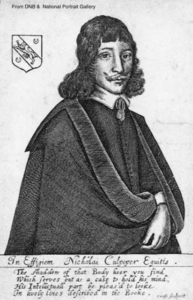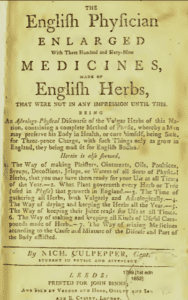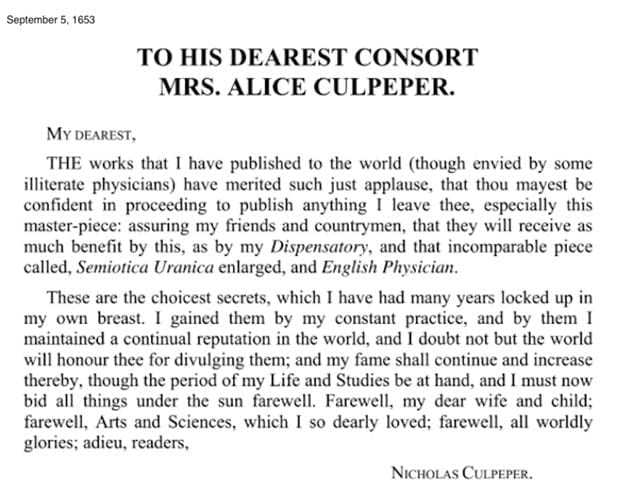JMS Pearce
Hull, England
 |
| Fig. 1 Nicholas Culpeper |
Apart from crude measures such as amputation and surgery without anesthesia, most medical treatments were ineffective until the twentieth century. Herbal remedies dominated from the time of ancient Hindu and Chinese cultures. Herbals were used by the Greek scholar Theophrastus (371 – 287 BC) and by Pedanius Dioscorides (AD 40 – 90), a surgeon in the Roman Army, whose De Materia Medica was for centuries the bible of herbal remedies. But out of hundreds of botanical and herbal remedies only a few derivatives such as aspirin, quinine, digitalis, and opiates proved their worth. Herbal medicines were, however, popular and remain so though many were useless and some toxic.
In the seventeenth and eighteenth centuries, because very few doctors were accredited by the College of Physicians, apothecaries (pharmacists) and barber-surgeons provided most of the treatment for the population. In England in the 1700s, apothecaries were five times as numerous as physicians, and were allowed to practice without having studied at a university. As a City Livery Company, the Worshipful Society of Apothecaries had jurisdiction over the trade and the profession of apothecary started on 6 December 1617. Until the Apothecaries Act of August 1815 it was restricted to the City of London and within a seven-mile radius. The Act enabled the License in Medicine and Surgery of the Society of Apothecaries (LMSSA) to approve apothecaries as medical practitioners; the last diploma was awarded in 2003 and the United Examining Board UEB was dissolved in 2007.
Nicholas Culpeper (1616-1654)
Historically, treatments included: spices, herbs, purgatives, laxatives, emetics, comfits, antidotes, aphrodisiacs, antiseptics, and tonics. Foremost in their development was Nicholas Culpeper (Fig 1.) whose work as an astrological apothecary,2,3 is still remembered and whose Complete Herbal (Fig 2.) was an enduring text.4 He was also infamous as a rebel against the medical and other establishments.5 Details of his dramatic and varied life6 derive mainly from a brief biography of uncertain accuracy published posthumously by William Ryves.7
Culpeper was born less than two miles away from the end of Gatwick Airport’s runway. Only nineteen days before his birth in 1616, his father Nicholas, of aristocratic stock, died. His mother Mary was therefore forced to return with her baby to her puritanical father, the Reverend William Attersoll, rector of St. Margaret’s Church in Isfield, Sussex. Attersoll had no great affection for children but saw it as his duty to provide instruction for his grandson in classics, mathematics, and astronomy. Nicholas however, became interested in local plants known to herbalists as simples; his mother and prevailing local folklore made him aware of their claims for medicinal properties.
His grandfather Attersoll arranged for him to study theology at Cambridge when aged sixteen, but this he quickly abandoned and chose to read Galen and Hippocrates and attend anatomy lectures. He fell in love with a childhood friend, Judith, the daughter of Sir John Shurley, a prosperous Baronet of Isfield. According to an unverified story, whilst trying to elope her carriage was struck by lightning and she was killed. Distraught, Nicholas deserted his studies at Cambridge to serve as apprentice apothecary to Simon White at Temple Bar.
University-educated physicians and apothecaries had different rights of practice and privileges: as an unqualified apprentice Nicholas felt excluded. (I have found no evidence that he obtained an ‘MD’ which accompanies his name in several of his publications). Apothecaries dispensed remedies, and frequently diagnosed illnesses because graduate physicians were so few. Culpeper provoked a conflict with the College of Physicians, which was anxious to protect its statutory monopoly. To make matters worse, White’s practice failed and he ran off to Ireland leaving the apprentice Nicholas in poverty with license from neither apothecaries nor physicians. He soon found a new teacher, Francis Drake, but when in 1639 Drake died the rights to practice of Culpeper and his partner Samuel Leadbetter were challenged.9
In 1640, he married Alice Field who brought with her a fortune sufficient to pay for a house built in Red Lion Street, in poor and unfashionable Spitalfields, just outside the city walls of London. In 1644 he established a successful practice and remained there for the rest of his life. It lay just outside the jurisdiction of the Royal College of Physicians for the practice and teaching of physic within a radius of seven miles of St. Paul’s Cross.
Culpeper’s Complete Herbal
 |
| Fig. 2 The English Physician (Culpeper’s Herbal) |
Culpeper was a botanist, herbalist, apothecary, and astrologer, known for his respected book: 4
THE ENGLISH PHYSITIAN, OR AN ASTROLOGO-PHYSICAL DISCOURSE OF THE VULGAR HERBS OF THIS NATION BEING A COMPLEAT METHOD OF PHYSICK, OR CURE HIMSELF BEING … AS GROW IN ENGLAND/ BY NICH. CULPEPER. (1652)
Costing three pence, it provided a comprehensive list of medicinal herbs, indexed to a list of typical illnesses, using an astrological rather than a Galenic approach.6 It was known as Culpeper’s Complete Herbal. However, gradually belief in celestial forces and astrology waned and Culpeper’s works were impugned. His reputation was further scarred by an incident in December 1642, when a patient falsely accused him of witchcraft, but the trial jury fortunately swiftly acquitted him.
He continued to treat many poor patients for meagre charges. He became popular despite the bitter condemnation of The College of Physicians because in 1649, Culpeper produced a critical English translation A Physical Directory of the College’s Pharmacopoeia Londoninensis that published in Latin was unintelligible to most people. While the Pharmacopoeia contained recipes for many herbal remedies, Culpeper’s translation added vital instructions on how to make the medicines where the Pharmacopoeia’s recipes were too short or deliberately unclear.
We may wonder where Culpeper obtained his ideas and precepts. A recent biography8 shows that he adopted many ideas from Paracelsus von Hohenheim (1493–1541). Paracelsus and other reformers had rejected traditional medical authority and advanced the old idea of the Doctrine of Signatures. This claimed that the form, taste, or smell of a plant indicated its application in treatment. For instance, the leaf of Hepatica acutiloba was used to treat liver diseases because it was shaped like the liver. Walnuts were good for curing head ailments because resembling the brain they had the perfect Signatures of the Head.9 For example, Culpeper related:
“The lily of the valley [Convallaria majalis] cureth apoplexy by Signature; for as that disease is caused by a drooping of humours into the principal ventricles of the brain: so the flowers of this lily hanging on the plants as if they were drops, are of wonderful use herein”.
Additionally, he developed his own plant-based remedies but also relied on astrology for many of his practices.
Only in recent years has his reputation been partly rescued from historians’ derision of him as a quack.10 He published several books in English, giving the public access to medical and pharmaceutical practices. His biggest success was The English Physician (Culpeper’s Herbal) (Fig 2). It tried to rationalize and unify the doctrine of signatures, astrology, and herbal remedies. It was also a spirited protest against the orthodox establishment of the College of Physicians and what he perceived as their Latinized concealment of much of herbal medicine from the public. Although the College protested, his book remained in print.
His political radicalism was not however confined to College physicians; he inveighed against the King, priests, and lawyers. He dedicated himself to serving the sick, the poor, and the powerless. He was however provocative, and modesty was not his strongest suit as his self-appraisal shows:
 |
When the Civil War began in 1642, Culpeper, an anti-royalist, enlisted as a field surgeon with the Parliamentarians and employed medicinal herbal treatments to treat the wounded. He was shot in the chest but survived. As a longstanding smoker and sufferer from tuberculous consumption, he died three years later, aged thirty-nine.
Late texts
The Oxford Dictionary of National Biography records:
Culpeper’s Ephemeris for 1653, his last, appeared amid a steady stream of the medical publications that were his chief concern. His own work included A Directory for Midwives (1651), and Semiotica uranica, or, An Astrological Judgement of Diseases from the Decumbiture of the Sick (1651). There were also more translations: Treatise of the Rickets (1651), from Francis Glisson’s De rachitide sive morbo puerili, qui vulgo ‘the rickets’ dicitur, tractatus; Galen’s Art of Physick (1652), from the Ars medica; and The Anatomy of the Body of Man (1653), from John Vesling’s Syntagma anatomicum.6
Never refraining from furthering his own reputation, Culpeper was a vexing, confrontational, if essentially benevolent character, who received much vindictive criticism. But he was important for the medical practice and public health education of his time. His lasting epithet was “physician of the people,” for whom he worked hard and gave access to knowledge of herbal remedies.
Times change and the present role of herbal medicine has been summarized by NHS UK [2018]:11
Evidence for the effectiveness of herbal medicines is generally very limited. Although some people find them helpful, in many cases their use tends to be based on traditional use rather than scientific research.
References
- Dunea G. Apothecaries vs. physicians. Hektoen International Journal, Summer 2018
- Tobyn G. Culpeper’s Medicine (Shaftsbury, Dorset: Element Books, 1997)
- Woolley B. Heal Thyself: Nicholas Culpeper and the Seventeenth-Century Struggle to Bring Medicine to the People (New York: HarperCollins, 2004)
- Culpeper N. The English Physician (The complete herbal) 1653. Full text at https://www.gutenberg.org/ebooks/49513
- The English Physician. History today October 2016. https://www.historytoday.com/history-matters/english-physician
- Curry P. Culpeper, Nicholas (1616–1654). Oxford Dictionary of National Biography Sept 2004. https://doi.org/10.1093/ref:odnb/6882
- Ryves William. ‘The life of the admired physician and astrologer of our times, Mr. Nicholas Culpeper’, in Culpeper’s school of physick (1659)
- Thulesius Olav. Nicholas Culpeper: English Physician and Astrologer. London, Macmillan Press 1992.
- Pearce JMS. The doctrine of signatures. Eur Neurol 2008;60:51–52
- Poynter FNL. ‘Nicholas Culpeper and his books’, Journal of the History of Medicine and Allied Sciences. 1962; 17:152–67
- NHS UK. Herbal medicines. 2018. https://www.nhs.uk/conditions/herbal-medicines/
JMS PEARCE, MD, FRCP, is a retired neurologist and author with a particular interest in the history of science and medicine.
Spring 2019 | Sections | History Essays

Leave a Reply